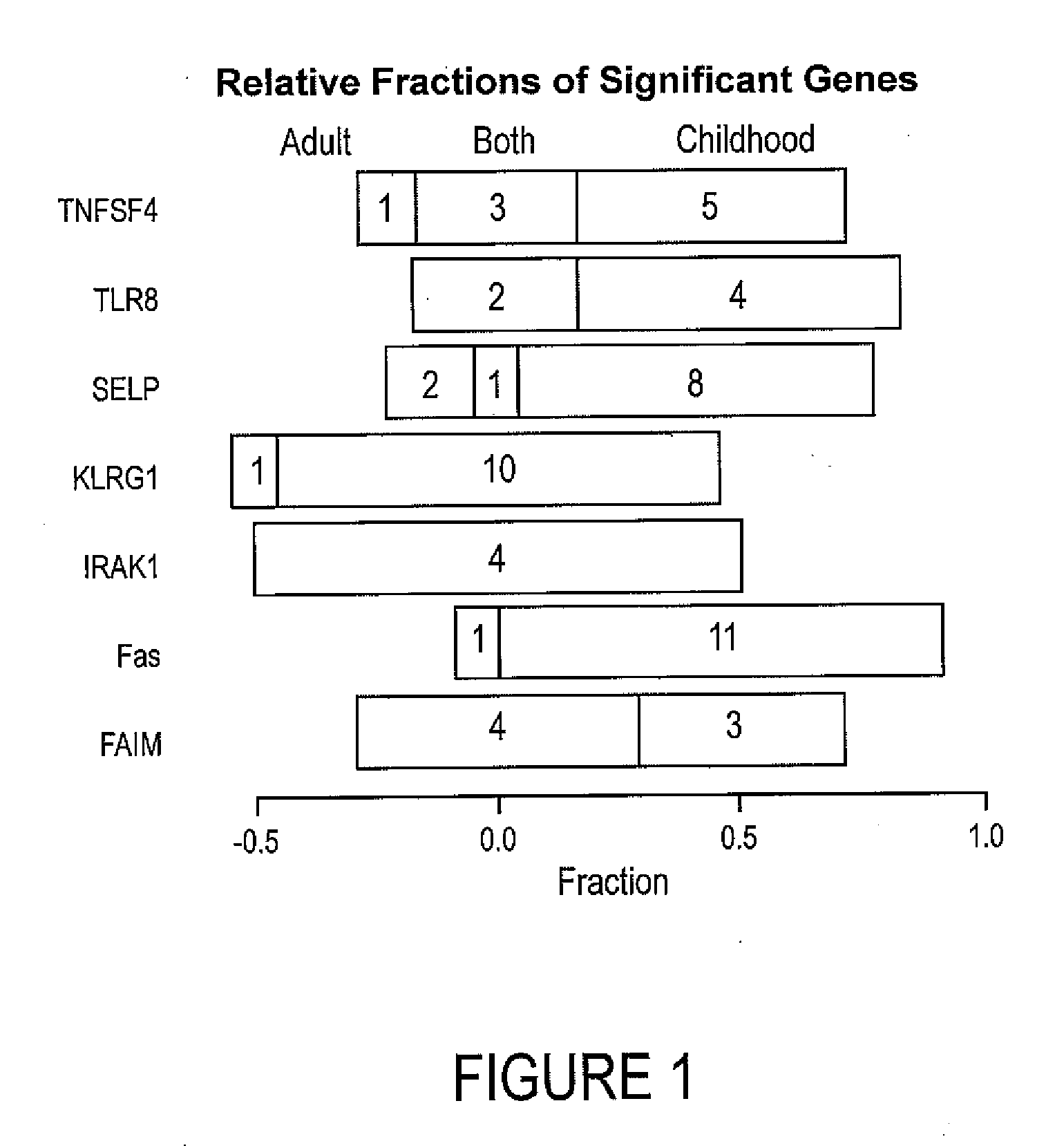Autoimmune genes identified in systemic lupus erythematosus (SLE)
a technology of autoimmune genes and genes, applied in the field of autoimmune diseases, can solve the problems of low detection power of common-variant with modest effects, low correlation rate of false positive results reported by such studies, and inability to reproduce association studies performed on a wide random selection of genes
- Summary
- Abstract
- Description
- Claims
- Application Information
AI Technical Summary
Benefits of technology
Problems solved by technology
Method used
Image
Examples
example 1
[0018]We have adopted a Bayesian approach, in which rather than initially concentrating on specific candidate genes, we developed a collection of candidate pathways. To this end, we have taken advantage of the accumulated data from genome-wide scans of adult SLE families, candidate gene investigations, information gained from genetics of mouse models of lupus and the gene expression profiling data of human SLE. Based upon our extensive literature search and examination, we selected a list of candidate functional pathways judged to be relevant to the pathogenesis of SLE. Three databases (NCBI, GeneCards, Harvester) were searched using a set of keywords representing these functional pathways. This initial inclusive search resulted in the selection of 6,384 genes. Subsequent analyses excluded genes based on their expression pattern or function in unrelated processes (e.g. believed to only be involved in embryogenesis or expressed in tissues deemed irrelevant), or genes included solely ...
example 2
[0104]Systemic lupus erythematosus (SLE) is a debilitating multisystem autoimmune disorder affecting 0.1% of the North American population (predominantly females). It is characterized by chronic inflammation in various organ systems such as the skin, joints, kidneys, lungs, and brain and the production of autoantibodies to multiple self antigens ([1]). Genome-wide linkage studies have been performed in small to medium-sized collections of families with 2 or more affected members, and several genetic intervals have been identified ([2-7]), some of them corroborated in 2 or more independent studies ([8-11]). Taken together, the findings of these studies suggest that multiple genes contribute to the pathogenesis of SLE, each providing quite modest genetic effects. Furthermore, these studies have shown that the genetics of SLE are not dominated by a single major genetic effect (such as the effect of HLA in type 1 diabetes mellitus or rheumatoid arthritis, both autoimmune diseases).
[0105...
example 3
[0193]Many common disorders have genetic components which convey increased susceptibility. While linkage and association analyses have been quite successful in identifying rare variants with high penetrance, such as in Huntington's disease [1] and some forms of cancer [2], the ability of these approaches to detect common variants with more modest effects (less penetrance) is limited. Frequent alleles with modest genetic effects play important roles in the susceptibility to most diseases. For example, most autoimmune disorders involve multiple alleles of different genes with individual low penetrance which also interact with environmental factors to produce the final disease phenotype. Dissecting the disease phenotype into the individual genes and associated alleles that are responsible is crucial for understanding the mechanism of the disease and ultimately developing treatment modalities [3]. To this end, many researchers have been using genome-wide approaches to locate Single Nucl...
PUM
| Property | Measurement | Unit |
|---|---|---|
| concentration | aaaaa | aaaaa |
| statistical power | aaaaa | aaaaa |
| time | aaaaa | aaaaa |
Abstract
Description
Claims
Application Information
 Login to View More
Login to View More - R&D
- Intellectual Property
- Life Sciences
- Materials
- Tech Scout
- Unparalleled Data Quality
- Higher Quality Content
- 60% Fewer Hallucinations
Browse by: Latest US Patents, China's latest patents, Technical Efficacy Thesaurus, Application Domain, Technology Topic, Popular Technical Reports.
© 2025 PatSnap. All rights reserved.Legal|Privacy policy|Modern Slavery Act Transparency Statement|Sitemap|About US| Contact US: help@patsnap.com



